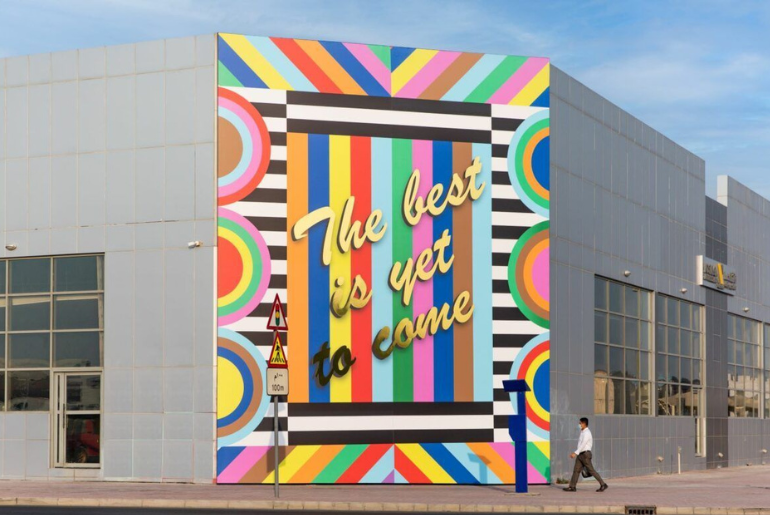Dubai is well-known for its glittering skyline, opulent lifestyle, and modern architecture; but Al Quoz, an artistic neighbourhood bursting with creative energy, raw authenticity, and original artistic ventures hidden away from tourist paths and flashy districts contrasts sharply with the shiny sheen of downtown Dubai. Originally only an industrial zone, Al Quoz has become one of Dubai’s most sought-after creative and cultural venues.
From Warehouses to Art Galleries
Al Quoz is famously defined by its sprawling grid of warehouses and factories built to support Dubai’s commercial expansion. For decades these utilitarian structures served as storage spaces, workshops and distribution hubs; but starting in the early 2000s an increasing number of artists, curators, and entrepreneurs began taking back these spaces by turning them into contemporary art galleries, performance venues or creative studios.
Its transformation was spearheaded by visionaries who saw beyond its industrial facade and recognized the unrealized potential in high ceilings, wide open interiors and more affordable space than elsewhere in Dubai. Alserkal Avenue eventually came into being as part of this transformation process–now serving as one of Al Quoz’s central cultural revitalizations points with some influential galleries like The Third Line Gallery Carbon 12 Gallery Leila Heller Gallery calling this area home.
A Thriving Community of Creatives
Al Quoz stands out among artistic communities due to the vibrant community it boasts, not only due to the art it displays but also through an eclectic group of creative individuals that call Al Quoz their home. Artists from around the globe have set up studios there and contribute significantly towards an internationalized, dynamic, collaborative atmosphere; as such their artistic output embodies both local culture and global awareness simultaneously.
Al Quoz is home to more than just visual art; its presence can also be felt through performance spaces, experimental theaters and music venues such as The Junction in Dubai for playwrights, stand-up comedians and actors; while The Fridge offers regular musical events tailored towards Dubai audiences.
Al Quoz gives musicians a platform free from mainstream expectations so they may explore. This neighbourhood thus promotes authenticity, unvarnished originality and actual innovation—an atmosphere in which art exists outside of mere exhibition but felt and experienced first-hand.
Al Quoz Goes Beyond Art
While art may be at the core of Al Quoz’s identity, it’s far from its only draw. Al Quoz has become home for independent cafes, boutique fitness studios, artisan retailers and cafes like Wild & The Moon Coffeehouse or Nightjar Coffeehouse that not only serve up delicious fare and beverages but are community gathering spaces – offering open mic nights or hosting art talks in line with its artistic values.
Its businesses are becoming more engaged with sustainability and social impact initiatives, with stores and restaurants that emphasize locally sourced materials, ethical production processes and eco-friendly operations embracing them with open arms – this aligns perfectly with the values held dear by its creative community.
It has recently witnessed an upsurge of experiential concepts such as immersive art installations and pop-up events hosted in transformed warehouse spaces – providing unique, ever-evolving experiences that keep residents and visitors coming back time after time.
Read Also: Discover the Cultural Highlights of Al Ain on a City Tour from Dubai
Navigating Al Quoz
Al Quoz may appear disarmingly charming at first, yet first-timers may find navigating its maze-like urban landscape difficult and even intimidating at times.Al Quoz needs either past research or direction to properly enjoy without any pedestrian infrastructure and obvious signage guiding people through it all. But its appeal is exactly in the lack of pedestrian infrastructure in this unexplored area, which makes Al Quoz appealing for exploration even if it satisfies curiosity over well-known tourist areas in Dubai.
On building exteriors, street art and murals are now more and more visible as visual signals regarding what is inside. Moreover, these artistic manifestations act as navigating guides, pointing out gallery openings, art installations or cultural events happening indoors.
New metro extensions and bus lines have made the area more accessible, hence improving transportation choices; still, many people choose driving or taxi service when visiting several sites at once.
A Glimpse into the Future
Al Quoz is crucial in preserving harmony between economic success and real artistic expression as Dubai keeps working to be a cultural centre. Plans call for this region to be formally recognised as a creative district with upgraded infrastructure, specific pedestrian areas, and more public art projects.
Al Quoz requires striking a delicate balance. At its heart lies Al Quoz’s gritty charm and grassroots spirit; excessive development or commercialization could jeopardize what makes the area unique in the first place. Urban planners and cultural leaders understand this risk well; many collaborate closely with creative community members to ensure future expansion respects previous success.
Al Quoz Remarks
Within an otherwise fast-paced city like Dubai, Al Quoz stands out as something different and delightfully different: an area in which art is not an extravagant extra but part of life itself and creativity thrives everywhere. Al Quoz provides visitors looking beyond the regular Dubai experience a more satisfying glimpse into Dubai’s soul and history.
Al Quoz is an ideal destination to discover for tourists seeking unusual experiences, residents looking for deeper engagement with local culture or artists looking for new inspiration. Not only is Al Quoz Dubai’s artistic hub; its sheer existence stands as testament to creativity’s transformative potential within spaces, communities and lives alike.
Author’s Bio
Sarah Malik is a travel journalist and cultural storyteller who has spent over a decade exploring the Middle East. Her work focuses on urban development, lifestyle, and local traditions. She writes regularly for PeaceLandTravel, where she shares in-depth insights into the evolving landscapes of global cities like Dubai.


